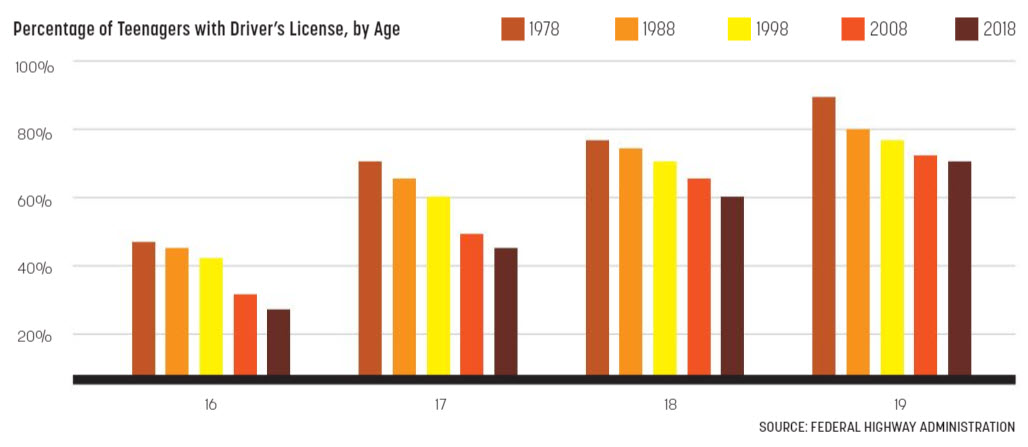By John Eichberger
“The road is calling and I must go.” Those are the words on the framed poster above my desk, hovering above the image of Porsche 911 cruising on a winding mountain road. The open road has been a siren’s call for me my entire life—but that draw, that love affair with cars and driving that has been so strong throughout America’s recent history, seems to be fading away…especially among younger generations who are more drawn to technology than shiny objects on wheels. That, however, could represent an opportunity for the auto industry to regain some of its appeal.
Feels So Good
In early October, I followed the message on that poster and took a two-day trip in my manual- transmission-equipped 2003 Porsche 911 and hit the winding mountain roads of southwest Virginia, losing myself with my first true love—driving. As I carved around hairpin turns, stomping on the breaks, flicking the gear shift and hammering down on the gas pedal, the power and insight of Van Halen took over. I did not have to ask “When It’s Love”—it was “Right Now” and I became one with the vehicle and the asphalt below me.
The Dream Is Over
I know I sound like my parents, but things have seriously changed. The manual transmission in my vehicle is a dinosaur—less than 2% of vehicles produced in 2019 were equipped with three pedals on the floor, and only 11% delivered power to the rear wheels. When I started driving, stick shifts at least were still found in 27% of new vehicles, and rear wheel drive was found in 30%. So many features of modern vehicles have taken control away from the driver. While this has without a doubt improved efficiency and safety, I believe it also has contributed to commoditizing the transportation experience and eroded that connection between car and driver.
I’ll Wait
In 2014, the Fuels Institute published “Driver Demographics—The American Population’s Effect on Vehicle Travel and Fuel Demand.” The trends highlighted in the report lead me to assume more and more kids are saying “I’ll Wait” with regards to getting their driver’s license. It showed that the number of Americans in their 20s who possessed driver’s licenses had dropped from 91% in 1982 to 81% in 2012. It also showed that the percentage of U.S. vehicle miles traveled driven by those under the age of 34 had declined from 45% in 1983 to just 29% in 2009.
Except for those older than 60 years, every age group has seen a decrease in the percentage of its population with a driver’s license. And it is especially pronounced among teenagers, where fewer than 50% of those 17 years of age have a license.
Everybody Wants Some
There are a few reasons why young people are not driving as much, including changes in teen licensing and driving laws in many states, as well as the high cost of vehicles, fuel and insurance. I also submit that today’s youth need not travel to interact with one another—they can do so virtually through technology.
According to a 2018 survey conducted by Common Sense, a non-profit that researches kids and their relationship to media and technology, the share of 13 to 17 year-olds who have their own smartphone increased from 41% in 2012 to 89% in 2018. Common Sense also found than teens spend on average more than seven hours every day on screen media for entertainment (not counting virtual schooling). And Pew Research Center found that 60% of teenagers say they get together with their friends online every day, outside of school activities; by contrast, only 24% visited friends in person every day.
Best of Both Worlds
But there is potential opportunity to reignite an attraction to vehicles. The new vehicles entering the market are loaded with technology, and this trend is expected to accelerate. The successful features installed in new electric vehicles (e.g., large touch-screen control modules) are being installed in combustion engine vehicles with very high penetration rates. Newer vehicles are beginning to resemble rolling computers. I believe technology-focused younger buying cohorts will pay attention and respond positively.
Why Can’t This Be Love?
The love affair with our vehicles that has existed in the past focused on style, performance, handling and speed. Why can’t a new love affair be inspired by vehicle infotainment systems and the ability of the vehicle to keep its driver connected with their social networks (which itself increases the value of continually improving advanced driver assist systems)? And maybe while they are enjoying the new tech features, they will experience some additional joy in exploring the world around them while navigating their vehicles.
Until then, I will continue standing on “Top of the World” and “Running with the Devil,” enjoying every moment behind the wheel and creating memories that can “Take Me Back (Deja Vu)” to the hey days of America’s love affair with our cars.
And to Eddie Van Halen, who recently passed, thank you for the soundtrack.
 John Eichberger is executive director of The Fuels institute.
John Eichberger is executive director of The Fuels institute.
For more information, visit www.fuelsinstitute.org.











